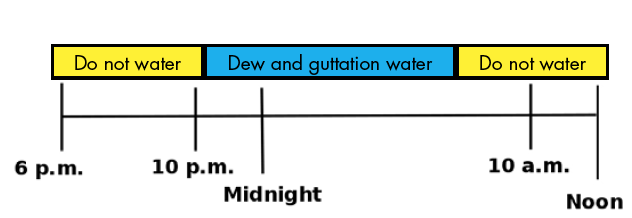The Plant Doctor: Watering and Plant Disease
Water, especially water droplets on leaves and stems, plays a major part in plant diseases. Unlike other important factors, such as temperature, you can sometimes control water and moisture. By understanding a few basic principles of how free water (water droplets and films of water on the surface of plant tissues) relates to plant disease and by watering appropriately, you can limit disease in your garden.
Most plant diseases in the state are caused by fungi, but bacterial diseases also occur. Fungi and bacteria that can cause disease are called pathogens. They spread by seed-like structures called spores or by cells.
The fungal spores and bacterial cells are often not released until they have been wet for a certain period. Once released, they may be carried on the wind, in raindrops, or in irrigation water. Fungi and bacteria must have water to spread and infect plants.
Fungal spores are small and delicate (Figure 1). Like plant seeds, they require moisture to begin germination, and once they germinate, they die if they dry. Many fungi require a film of free moisture for at least 9 hours to germinate and penetrate the plant leaf. Some require slightly less time and others more.

Splashing water droplets move pathogen “seeds” short distances. The splash carries the “seeds” from the soil to lower plant leaves, from the lower plant leaves to the upper plant leaves, and from one plant to another. The “seeds” may move longer distances by windblown water droplets.
Moisture is the critical factor in disease development. The amount of disease depends on the number and length of wet periods.
You can control many plant diseases by controlling the number of the free moisture periods and how long those periods last. Reduce the number of periods by watering only when needed, and then watering deeply.
Reduce the amount of time leaves are wet. Remember that dew is water, too, so your watering schedule has to account for it. Do not extend the period of leaf wetness by watering as the dew is beginning to dry in the morning or before it forms in the evening (Figure 2). Extending the period of leaf wetness will let more pathogen “seeds” germinate.

Observe how long the dew stays on the plant canopies and turf; then water when the dew would normally be on the plants. Dew is usually present from about midnight to 8:00 in the morning. If watering in the evening, make sure you stop watering early enough that the watered areas dry before dark. If watering in the morning, stop early enough that the watered areas dry at the same time as or before unwatered areas.
A plant has leaves on the outside and on the inside of its canopy. The inside leaves are sheltered from direct sun and drying winds, so water will stay longer on them. Plants shade the soil, slowing the drying time and raising the humidity levels around the plants. This means diseases are more likely to become established inside the plant canopy than on the outside.
Reduce disease inside plant canopies with proper pruning and landscaping. Make best use of morning winds and sun to dry your landscape. You may hasten drying of particularly valuable areas of turf or plants by brushing a bamboo pole or pulling a garden hose over them to remove the dew drops.
Consider using drip irrigation in your established plantings and soaker hoses in your more temporary ones. If watering by hand, try to water at the base of plants. Drip irrigation and watering at the soil level will help reduce the amount of free moisture on plant canopies. This won’t be possible with your lawn, so water it at the proper time.
How Much to Water
Have you ever noticed that as you dig a hole, the soil becomes moister the deeper you dig? Even when the upper soil layers are quite dry, the deeper layers are moist. So there is more moisture deeper in the soil.
How does water get into the plant? Through the roots. So, putting the two together, you want the plant roots to penetrate as deeply into the soil as possible—to avoid the drying cycles of the upper soil layers.
How can you do this? Encourage the roots to grow deeply. Just as branches twist and turn to get more light, roots grow toward a supply of water.
If the area is constantly watered lightly, there will be enough soil moisture just below the surface for the plants. But the soil moisture will dry up quickly and leave plants dessicated in hot weather. Instead, water deeply so the moisture penetrates to about 4 inches. Then, don’t water until it is needed. See Figure 3.

You can check the depth of the soil moisture using an unpainted wooden dowel like you use a toothpick to check if a cake has fully baked. Soil crumbs clinging to the dowel indicate moist soil.
By understanding the association of free moisture to disease development and by changing your watering practice to cut the duration of leaf wetness and number of irrigations, you can lessen disease in your landscape.
The information given here is for educational purposes only. References to commercial products, trade names, or suppliers are made with the understanding that no endorsement is implied and that no discrimination against other products or suppliers is intended.
Publication 3881 (POD-05-22)
By Alan Henn, PhD, Extension Professor, Plant Pathology.
The Mississippi State University Extension Service is working to ensure all web content is accessible to all users. If you need assistance accessing any of our content, please email the webteam or call 662-325-2262.




